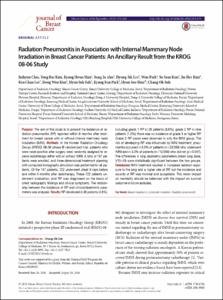KUMEL Repository
1. Journal Papers (연구논문)
1. School of Medicine (의과대학)
Dept. of Radiation Oncology (방사선종양학)
Radiation Pneumonitis in Association with Internal Mammary Node Irradiation in Breast Cancer Patients: An Ancillary Result from the KROG 08-06 Study
- Keimyung Author(s)
- Kim, Jin Hee
- Department
- Dept. of Radiation Oncology (방사선종양학)
- Journal Title
- Journal of Breast Cancer
- Issued Date
- 2016
- Volume
- 19
- Issue
- 3
- Abstract
- Purpose : The aim of this study is to present the incidence of radiation pneumonitis (RP) reported within 6 months after treatment for breast cancer with or without internal mammary node irradiation (IMNI).
Methods : In the Korean Radiation Oncology Group (KROG) 08-06 phase III randomized trial, patients who were node-positive after surgery were randomly assigned to receive radiotherapy either with or without IMNI. A total of 747 patients were enrolled, and three-dimensional treatment planning with computed tomography simulation was performed for all patients. Of the 747 patients, 722 underwent chest X-rays before and within 6 months after radiotherapy. These 722 patients underwent evaluation, and RP was diagnosed on the basis of chest radiography findings and clinical symptoms. The relationship between the incidence of RP and clinical/dosimetric parameters was analyzed.
Results : RP developed in 35 patients (4.8%), including grade 1 RP in 26 patients (3.6%), grade 2 RP in nine patients (1.2%); there was no incidence of grade 3 or higher RP. Grade 2 RP cases were observed in only the IMNI group. The risk of developing RP was influenced by IMNI treatment; pneumonitis occurred in 6.5% of patients (n=23/356) who underwent IMNI and in 3.3% of patients (n=12/366) who did not (p=0.047). The differences in lung dosimetric parameters (mean lung dose, V10–40) were statistically significant between the two groups.
Conclusion : IMNI treatment resulted in increased radiation exposure to the lung and a higher rate of RP, but the incidence and severity of RP was minimal and acceptable. This minor impact on morbidity should be balanced with the impact on survival outcome in future analyses.
- Keimyung Author(s)(Kor)
- 김진희
- Publisher
- School of Medicine
- Citation
- Jinhyun Choi, Yong Bae Kim, Kyung Hwan Shin et al. (2016). Radiation Pneumonitis in Association with Internal Mammary Node Irradiation in Breast Cancer Patients: An Ancillary Result from the KROG 08-06 Study. Journal of Breast Cancer, 19(3), 275–282. doi: 10.4048/jbc.2016.19.3.275
- Type
- Article
- ISSN
- 1738-6756
- Appears in Collections:
- 1. School of Medicine (의과대학) > Dept. of Radiation Oncology (방사선종양학)
- 파일 목록
-
-
Download
 oak-2017-0192.pdf
기타 데이터 / 232.66 kB / Adobe PDF
oak-2017-0192.pdf
기타 데이터 / 232.66 kB / Adobe PDF
-
Items in Repository are protected by copyright, with all rights reserved, unless otherwise indicated.